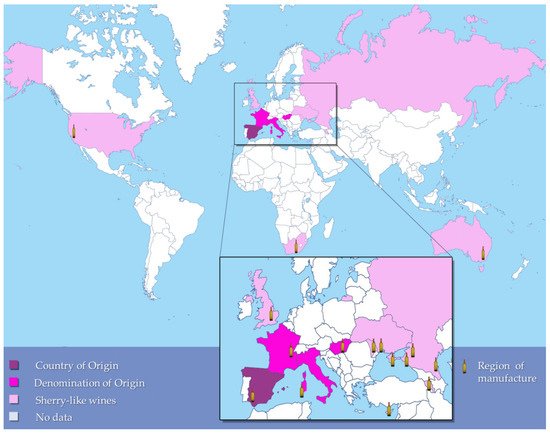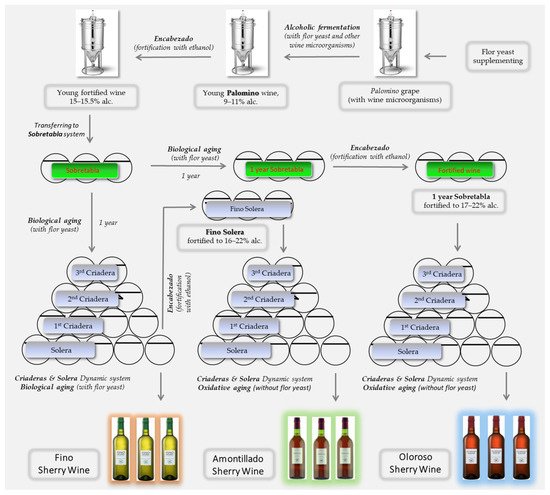The manufacturing of sherry wines is a unique, carefully regulated process, from harvesting to quality control of the finished product, involving dynamic biological aging in a “criadera-solera” system or some other techniques. Specialized “flor” strains of the yeast Saccharomyces cerevisiae play the central role in the sherry manufacturing process. As a result, sherry wines have a characteristic and unique chemical composition that determines their organoleptic properties (such as color, odor, and taste) and distinguishes them from all other types of wine.
- Saccharomyces cerevisiae
- sherry
- wine
- flor yeast
1. Introduction
2. Worldwide Production of Sherry and Sherry-like Wines
In addition to Spain, Denominación de Origen (DO) sherry wines have been registered in the European Union in Italy (Sardinia), France (Jura), and Hungary (Tokay Hegyal) under the brands Vernaccia di Oristano [19], Vin Jaune [20], and Szamorodni [21], respectively (Figure 1, Table 1). To make these, winemakers use local white grape varieties Vernaccia and Savagnin in Italy and France, as well as Furmint, Harslevelű, and Sárga Muskotály varieties in Hungary. DO sherry wines are produced according to the classical flor technology with biofilm formation [22].
Country | Region/City | Brand | Alcohol, % | Sugar, g/L | Type | Grape Varieties | References | ||||||||||||||||
|---|---|---|---|---|---|---|---|---|---|---|---|---|---|---|---|---|---|---|---|---|---|---|---|
Spain | Andalusia (Jerez de la Frontera, El Puerto de Santa María, Sanlúcar de Barrameda) | Fino | 15 | 0–5 | Dry (Vinos Generosos) | Palomino | |||||||||||||||||
Manzanilla | 15 | ||||||||||||||||||||||
Amontillado | 16–22 | ||||||||||||||||||||||
Oloroso | 17–22 | ||||||||||||||||||||||
Palo Cortado | 17–22 | ||||||||||||||||||||||
Dry | 15–22 | 5–45 | Sweet (Vinos Generosos de Licor) | Mix of Palomino, Pedro Ximénez, Moscatel de Alejandria | |||||||||||||||||||
Medium | 15.5–22 | 5–115 | |||||||||||||||||||||
Pale Cream | 15.5–22 | 45–115 | |||||||||||||||||||||
Cream | 15.5–22 | 115–140 | |||||||||||||||||||||
Moscatel | 15–22 | 160+ | Natural Sweet (Vinos Dulces Naturales) | Moscatel de Alejandria | |||||||||||||||||||
Dulce | 15–22 | 160+ | Pedro Ximénez | ||||||||||||||||||||
Pedro Ximénez | 15–22 | 212+ | |||||||||||||||||||||
Italy | Sardinia | Vernaccia di Oristano Bianco | 15 | N/D 1 | Dry | Vernaccia di Oristano | |||||||||||||||||
Vernaccia di Oristano Superiore | 15.5+ | ||||||||||||||||||||||
Vernaccia di Oristano Riserva | 15.5+ | ||||||||||||||||||||||
Vernaccia di Oristano Liquoroso | 16.5+ | Sweet | |||||||||||||||||||||
France | Jura | Vin Jaune | 14 | 0.4 | Dry | Savagnin |
[20] |
||||||||||||||||
Hungary | Tokaj-Hegyalja | Tokaji Szamorodni | 13.5 | 9 | Dry | Furmint, Hárslevelű, and Sárga Muskotály |
[21] |
||||||||||||||||
13.5 | 45+ | Sweet | |||||||||||||||||||||
USA | California | Sheffield Very Dry Sherry | 17 | 0.4–1.4 | Dry | Local Grape Varietes | |||||||||||||||||
Sheffield Cellars Cream Sherry | 18 | 10.6 | Medium Dry | ||||||||||||||||||||
Paul Masson Pale Dry Sherry | N/D | N/D | Dry | ||||||||||||||||||||
Paul Masson Medium Dry Sherry | Medium Dry | ||||||||||||||||||||||
Golden Cream Sherry | Sweet | ||||||||||||||||||||||
Australia | McLaren Vale | Tinlins Dry Sherry-Apera | 17.5 | N/D | Dry | Local Grape Varietes | |||||||||||||||||
Tinlins Cream Sherry-Apera | Sweet | ||||||||||||||||||||||
Tinlins Sweet Sherry-Apera | Sweet | ||||||||||||||||||||||
Tinlins Muscat Sherry-Apera | N/D | Sweet | |||||||||||||||||||||
Africa | South Africa | Old Brown Sherry | N/D | N/D | Dry | Local Grape Varietes | |||||||||||||||||
Cream Sherry | Medium Sweet | ||||||||||||||||||||||
Cyprus | Cyprus | Emva Cream Sweet Sherry | 15 | N/D | Sweet | Local Grape Varietes |
[24] |
||||||||||||||||
Emva Medium Dry Sherry | 17.5 | Medium Dry | |||||||||||||||||||||
UK | Bristol | Harveys Fino | 15 | 0 | Dry | Palomino |
[25] |
||||||||||||||||
Harveys Fine Old Amontillado | 19 | 5 | |||||||||||||||||||||
Harveys Palo Cortado | 19 | 19 | Palomino, Pedro Ximénez | ||||||||||||||||||||
Harveys Medium Dry | 17.5 | 38 | Medium Sweet | ||||||||||||||||||||
Harveys Rich Old Olorosso | 20 | 53 | Sweet | ||||||||||||||||||||
Signature by Harveys | 19 | 120 | Sweet | ||||||||||||||||||||
Harveys Bristol Cream | 17.5 | 135 | Sweet | ||||||||||||||||||||
Harveys Pedro Ximénez | 16 | 440 | Sweet | Pedro Ximénez | |||||||||||||||||||
Russia | Krasnodar Krai (stanitsa Golubitskaya) | Xeres Tamanskii | 20 | 30 | Medium Sweet | Sauvignon Blanc |
[26] |
||||||||||||||||
Rostov-on-Don | Xeres Krepki Donskoi | 19 | 3 | Dry | Aligote, Plavai, and Riesling |
[27] |
|||||||||||||||||
Republic of Dagestan (Derbent) | Xeres Dagestanskii | 19 | 30 | Medium Sweet | Rkatsiteli, Narma, Gulyabi, Khatmi, Ag-izym |
[28] |
|||||||||||||||||
Republic of Crimea | Yalta | Xeres Oreanda | 16 | 0 | Dry | Aligote, Albillo, Kokur |
[29] |
||||||||||||||||
Xeres Massandra | 19.5 | 25 | Medium Sweet | Sersial, Verdelho, Albillo |
[30] |
||||||||||||||||||
Xeres Magarach | Aligote, Sauvignon, Rkatsiteli |
[31] |
|||||||||||||||||||||
Ukraine | Odessa | Shabo Reserve Sherry Dessert | N/D | N/D | Medium Sweet | Muscat Ottonel | |||||||||||||||||
Moldova | Ialoveni | Ialoveni Sec Reserva | 16 | 0–5 | Dry | Muscat de Ialoveni, Aligote, Traminer, White Pinot, Rkatsiteli |
[33] |
||||||||||||||||
Ialoveni Armonios Reserva | 18 | 15 | Medium Dry | ||||||||||||||||||||
Ialoveni Tare Reserva | 20 | 30 | Medium Sweet | ||||||||||||||||||||
Ialoveni Desert Reserva | 19 | 90 | Sweet | ||||||||||||||||||||
Armenia | Ashtarak, Shaumyan, Echmiadzin | Ashtarak | 20 | 30 | Medium Sweet | Voskeat, Chilar |
[34] |
3. Sherry Wine Manufacturing Process
The history of the production of Spanish sherry goes deep into the past and is an integral part of the culture of the Andalusian region, which became possible due to the mild climatic conditions (3000 h of sunshine per year, an average annual temperature of 25 °C) [3]. Palomino Fino, Pedro Ximenez, and Moscatel grape varieties are traditionally used to produce high-quality sherry wines. The main types of classic dry sherry wines include the so-called Vinos Generosos (brands: Fino, Oloroso, Amontillado, Palo Cortado, and Manzanilla), Table 1. These dry wines are made from the same base wine but subjected to different aging procedures [38]. There are also blended fortified liqueur sweet wines in the category Vinos Generosos de Licor (brands: Dry, Pale Cream, Medium and Cream) and natural sweet wines in the category Vinos Dulces Naturales (brands: Pedro Ximénez, Moscatel and Dulce).3.1. Production of Fino Sherry Wines
In Spain, the process of making sherry wines of various types has a strict gradation by stages (Table 2, Figure 2). Fino brand wines are biologically aged dry sherries and go through successive stages of preparation. For Fino, first-pressed Palomino grapes must enter the stage of alcoholic fermentation in order to obtain a young wine (sobretablas stage, Spanish). At this stage, in addition to S. cerevisiae, it is possible to detect other wine microorganisms (Figure 2), such as lactic acid bacteria and non-Saccharomyces yeasts, whose growth may lead to organoleptic deviations and deterioration of the wine [39]. To prevent lactic acid bacteria development, lysozyme could be used, as its muramidase activity has an antibacterial action [39]. Concerning non-Saccharomyces yeasts, these could be Candida stellata, Dekkera anomala, Hanseniaspora guilliermondii, Hanseniaspora uvarum, Issatchenkia terricola, Starmerella bacillaris, Lachancea thermotolerans, and Torulaspora delbrueckii, which are often found in nature on the surface of grapes [40][41][42][43][44][40,41,42,43,44]. Further, the wine material is subjected to fortification (encabezado stage, Spanish) by adding ethanol at 15.0–15.5% (v/v ethanol), while the composition of the microflora changes dramatically—ethanol-sensitive microorganisms are almost completely replaced by sherry strains of S. cerevisiae, a distinctive feature of which is the ability to form a biofilm on the surface of the wine material—flor 1–3 cm thick [45]. Additionally, an important role in this process is played by such adaptive advantages of Saccharomycetes as high fermentation rate, resistance to alcohol, ability of anaerobic growth and rapid switching of metabolism from enzymatic to oxidative [42][46][47][42,46,47]. This sherry stage takes place in the criadera-solera system in oak barrels with a volume of 500–600 L [5][40][5,40]. It was shown recently that, in addition to Saccharomycetes, the wine microbiome at this stage may contain small amounts, of less than 0.5%, of the yeasts W. anomalus, P. membranaefaciens, P. kudriavzevii, and P. manshurica [5]. At present, their role in the maturation of sherry wines has not been elucidated [5]. In order for the flor to grow on the surface of the wine, the barrels are filled to 4/5 of their volume and arranged in pyramidal rows called “criaderas” [1][5][1,5]. There may be several such tiers, which are numbered from bottom to top, for example, for three tiers: first criadera, second criadera, and third criadera. The wine material is initially loaded into the uppermost tier, kept for a set time, and then enters the lower ones, until it reaches the very last, lower, “solera”, containing the oldest wine in the system. From here, the wine is sent for bottling. The bottom row of barrels is emptied by no more than 40% per year. Thus, the amount of wine withdrawn from the lower tier is compensated by the same amount from the upper tier [48]. The process of wine renewal is carried out 3–4 times a year; there is a constant circulation of wine material, and its organoleptic properties remain unchanged. The biological aging of wine material during its aging under the flor largely determines the properties of Fino brand wines and lasts at least 5 years [49][50][49,50]. The distinctive fruit and floral notes are formed in taste and aroma due to due to the formation of such compounds as farnesol, β-citronellol, β-ionone, and 1,1-diethoxyethane [49]. Additional characteristics are cheesy notes, such as rancidity and pungency due to the appearance of butanoic acid and acetaldehyde, respectively [49]. Fino brand wines have been shown to contain very little or no phenolic aldehydes [51]. This brand of sherry wine is also characterized by a pale shade, which is explained by the presence of a biological aging stage. It is assumed that the flor on the surface prevents the diffusion of atmospheric oxygen into the wine material, thereby preventing the appearance of brown pigments in it [51].
Major Properties | Sherry Wine Type | ||||||||||
|---|---|---|---|---|---|---|---|---|---|---|---|
Fino | Amontillado | Oloroso | |||||||||
The grape variety used in the manufacture | Palomino | Palomino | Palomino | ||||||||
Soil type used for cultivating grapes | White Albariza | White Albariza | White Albariza | ||||||||
Extraction of grape must | First | First | Second | ||||||||
Type of Aging | Biological | Mixed (Biological and Oxidative) | Oxidative | ||||||||
Final alcohol concentration, % | 15–15.5 | 16–22 | 17–22 | ||||||||
Main aromatic notes | Floral, Fruity, Cheesy, Chemical, Balsamic | Nutty, Smoky, Herbs, Ethereal | Nutty, Smoky, Dry Fallen Leaves, Spices, Truffles, Ethereal | ||||||||
Color | Pale Yellow | Golden-amber to Brown | Mahogany | ||||||||
